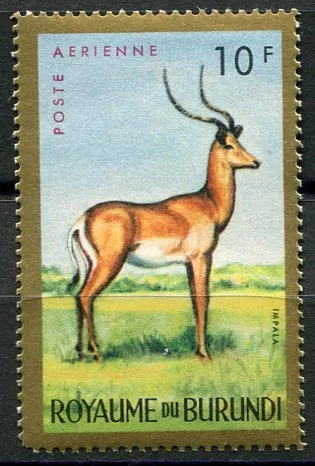- Home
- Philately: postage stamps
- Philately: stamps all over the world
- Africa
- Burundi
- (1964) MiNr. 104 A ** - Burundi - Air Stamp - Antelope
(1964) MiNr. 104 A ** - Burundi - Aerial Stamp - Antelope (Aepyceros melampus)
Burundi - postage stamps.

| Code: | BUR-104A |
| Producer: | Burundi |
| Price: | 0,77 EUR |
| Availability: | In Stock |
| Stock: | 1 Pcs |
| Denomination of the stamp: | 10 F |
| Year: | 1964 |
| Condition: | ** |
| Catalogue no. (MICHEL): | 104 A |
| Cat. number (St. Gibbons): | 94 |
| Cat. number (Yvert et Tellier): | PA 3 |
Impala (Aepyceros melampus): the speed and elegance of the African savannah
Impala (Aepyceros melampus) is a medium-sized antelope inhabiting eastern and southern Africa. It is one of the most abundant and well-known representatives of the African savanna and plays an important role in the ecosystems it inhabits. Its speed, grace and endurance often make it a symbol of adaptation and survival in the wild.
Systematics and Extensions
Impala belongs to the family Bovidae and the genus Aepyceros, which is monotypic - it includes only this single species. The scientific name Aepyceros melampus was first described in 1812 by the German zoologist Martin Hinrich Lichtenstein.
The natural range of the impala extends from Kenya and Tanzania through Zambia and Mozambique to northern South Africa, Botswana and Namibia. It is most commonly seen in sparse forests, open savannahs and near water sources.
Description and dimensions
Impala grow to a height of about 90 cm at the withers and weigh between 40 and 65 kg, with males noticeably larger than females. They have an elegant build, slender legs and smooth reddish-coloured fur. The male's distinctive feature is its spirally curled horns, which can measure up to 90 cm. Females are hornless.
The black-and-white markings on the back of the body and tail are also a typical identifying feature, playing a role in visual communication within the herd.
Breeding and social structure
Impalae are predominantly diurnal (diurnal) and form diverse social structures, ranging from female herds of up to 100 individuals, to territorial males, to bachelor groups of young bulls.
They are known for their exceptional agility and their ability to jump up to 3 meters in height and more than 10 meters in distance. This helps them escape predators such as lions, leopards, cheetahs and wild dogs.
Food
Impala are mixed herbivores - their diet consists of grasses as well as leaves, buds and fruits. This flexibility in their diet allows them to survive even during periods of drought, when they switch from grazing to gnawing.
Ecological importance
Impala is a keystone species for many African ecosystems. Not only does it serve as important prey for large carnivores, but its movement and grazing also influence vegetation structure and seed dispersal.
Conservation and status
According to the International Union for Conservation of Nature (IUCN), the impala is listed as a Low Concern species. Its population is stable and numbers several hundred thousand individuals. Due to its adaptability and distribution, it is not currently threatened, but locally it may be negatively affected by loss of habitat or overhunting.
Frequently Bought Together - (1964) MiNr. 104 A ** - Burundi - Aerial Stamp - Antelope (Aepyceros melampus)
From the Same Category - (1964) MiNr. 104 A ** - Burundi - Aerial Stamp - Antelope (Aepyceros melampus)
North Borneo - postage stamps A note from the series.
Burundi - postage stamps. The African Elephant: Kings of the African Savannah The African forest elephant ( Loxodonta africana ), the largest land animal in the world, is a true icon of the African wilderness. These giants can weigh up to 6 tonnes ...
Burundi - postage stamps. The Zebra and the Antelope: Encountering the Contrasts of the African Savannah The African savannah is home to many fascinating creatures, but few can capture your attention for their differences like the antelope and zebra ...





